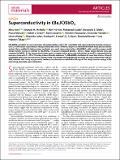Files in this item
Superconductivity in (Ba,K)SbO3
Item metadata
| dc.contributor.author | Kim, Minu | |
| dc.contributor.author | McNally, Graham M. | |
| dc.contributor.author | Kim, Hun Ho | |
| dc.contributor.author | Oudah, Mohamed | |
| dc.contributor.author | Gibbs, Alexandra S. | |
| dc.contributor.author | Manuel, Pascal | |
| dc.contributor.author | Green, Robert J. | |
| dc.contributor.author | Sutarto, Ronny | |
| dc.contributor.author | Takayama, Tomohiro | |
| dc.contributor.author | Yaresko, Alexander | |
| dc.contributor.author | Wedig, Ulrich | |
| dc.contributor.author | Isobe, Masahiko | |
| dc.contributor.author | Kremer, Reinhard K. | |
| dc.contributor.author | Bonn, D. A. | |
| dc.contributor.author | Keimer, Bernhard | |
| dc.contributor.author | Takagi, Hidenori | |
| dc.date.accessioned | 2022-05-06T09:30:23Z | |
| dc.date.available | 2022-05-06T09:30:23Z | |
| dc.date.issued | 2022-02-28 | |
| dc.identifier | 279392751 | |
| dc.identifier | beb74c3a-3e52-4700-95b2-4666dbc1c2cb | |
| dc.identifier | 85125304222 | |
| dc.identifier.citation | Kim , M , McNally , G M , Kim , H H , Oudah , M , Gibbs , A S , Manuel , P , Green , R J , Sutarto , R , Takayama , T , Yaresko , A , Wedig , U , Isobe , M , Kremer , R K , Bonn , D A , Keimer , B & Takagi , H 2022 , ' Superconductivity in (Ba,K)SbO 3 ' , Nature Materials , vol. First Online . https://doi.org/10.1038/s41563-022-01203-7 | en |
| dc.identifier.issn | 1476-1122 | |
| dc.identifier.other | ORCID: /0000-0002-7012-1831/work/112711398 | |
| dc.identifier.uri | https://hdl.handle.net/10023/25303 | |
| dc.description | Funding: This research was carried out in part due to funding from the Max Planck-UBC-UTokyo Centre for Quantum Materials. Part of the research described in this paper was performed at the Canadian Light Source, a national research facility of the University of Saskatchewan, which is supported by the Canada Foundation for Innovation, the Natural Sciences and Engineering Research Council, the National Research Council, the Canadian Institutes of Health Research, the Government of Saskatchewan and the University of Saskatchewan. We thank the Science and Technology Facilities Council ISIS facility for the provision of beamtime. | en |
| dc.description.abstract | (Ba,K)BiO3 constitute an interesting class of superconductors, where the remarkably high superconducting transition temperature Tc of 30 K arises in proximity to charge density wave order. However, the precise mechanism behind these phases remains unclear. Here, enabled by high-pressure synthesis, we report superconductivity in (Ba,K)SbO3 with a positive oxygen–metal charge transfer energy in contrast to (Ba,K)BiO3. The parent compound BaSbO3−δ shows a larger charge density wave gap compared to BaBiO3. As the charge density wave order is suppressed via potassium substitution up to 65%, superconductivity emerges, rising up to Tc = 15 K. This value is lower than the maximum Tc of (Ba,K)BiO3, but higher by more than a factor of two at comparable potassium concentrations. The discovery of an enhanced charge density wave gap and superconductivity in (Ba,K)SbO3 indicates that strong oxygen–metal covalency may be more essential than the sign of the charge transfer energy in the main-group perovskite superconductors. | |
| dc.format.extent | 11 | |
| dc.format.extent | 3569613 | |
| dc.language.iso | eng | |
| dc.relation.ispartof | Nature Materials | en |
| dc.subject | QC Physics | en |
| dc.subject | Chemistry(all) | en |
| dc.subject | Materials Science(all) | en |
| dc.subject | Condensed Matter Physics | en |
| dc.subject | Mechanics of Materials | en |
| dc.subject | Mechanical Engineering | en |
| dc.subject | NDAS | en |
| dc.subject.lcc | QC | en |
| dc.title | Superconductivity in (Ba,K)SbO3 | en |
| dc.type | Journal article | en |
| dc.contributor.institution | University of St Andrews. School of Chemistry | en |
| dc.contributor.institution | University of St Andrews. Centre for Designer Quantum Materials | en |
| dc.identifier.doi | https://doi.org/10.1038/s41563-022-01203-7 | |
| dc.description.status | Peer reviewed | en |
This item appears in the following Collection(s)
Items in the St Andrews Research Repository are protected by copyright, with all rights reserved, unless otherwise indicated.

